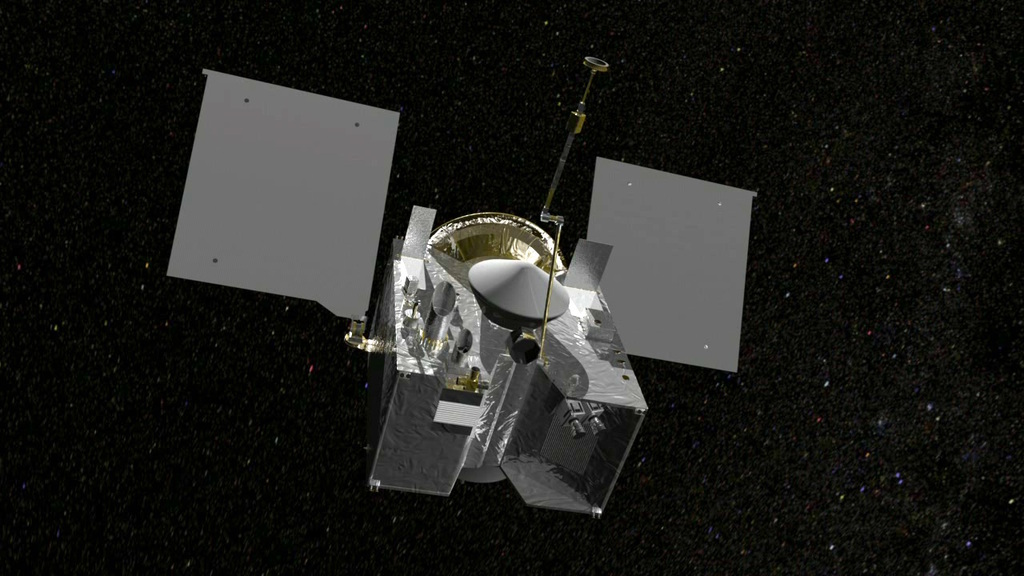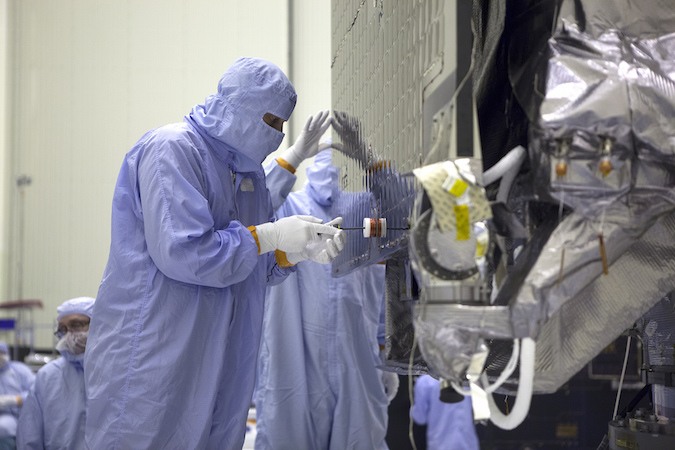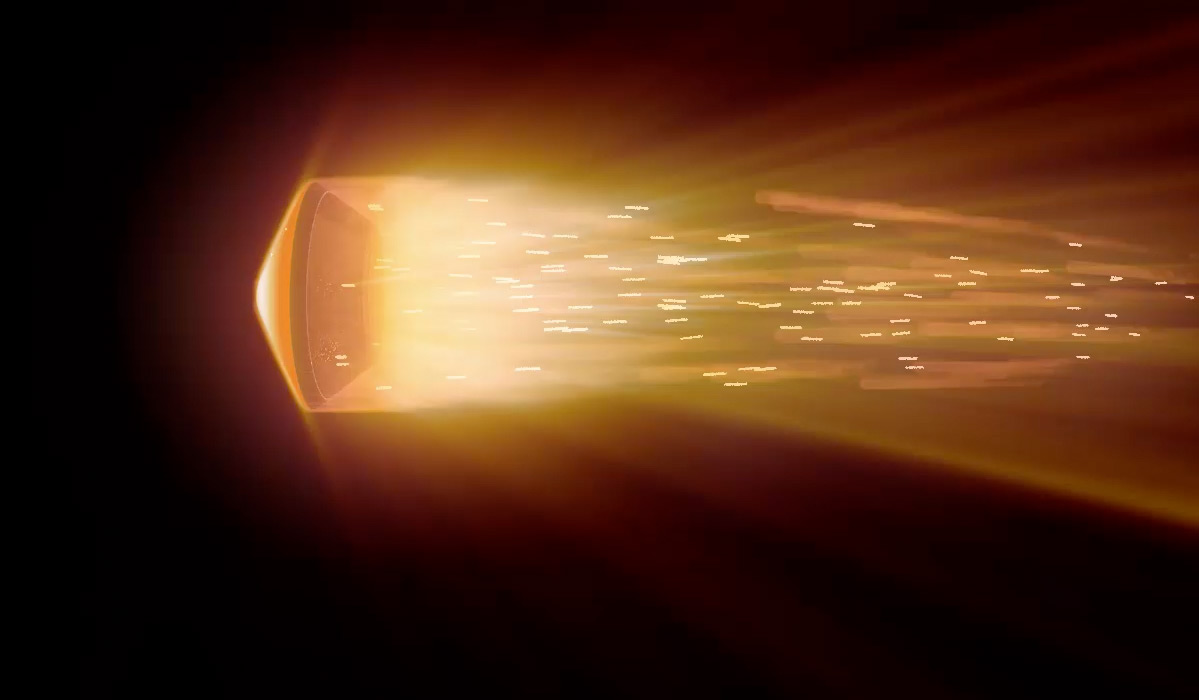
Five years after winning $1 billion from NASA to mount the first U.S. asteroid sample return mission, scientists and engineers will get their last look at the OSIRIS-REx spacecraft this week as it is closed up inside the nose cone of an Atlas 5 rocket for launch in September.
The probe’s encapsulation inside the Atlas 5’s payload fairing marks the end of a multi-year campaign to ensure every piece of the spacecraft meets stringent cleanliness standards. During construction, engineers tracked contaminants wherever OSIRIS-REx went on Earth, all the way down to concentrations measured in parts per billion.
Experts were especially concerned with organic residue left behind by humans and certain materials, like nylon and adhesives, normally used in the assembly of satellites.
OSIRIS-REx will bring back specimens for researchers to interrogate inside high-tech labs around the world, seeking clues about the origin of life, water and the planets themselves. The results could be skewed by an unexpected microbe or spore from planet Earth.
Small clumps of matter formed from a cloud of dust and gas at the dawn of the solar system. These proto-worlds grew into larger objects — and some became full-fledged planets — as they collided with one another, accreting more and more material along the way. Scientists believe asteroids brought the ingredients of life to Earth.
Analysts will look for amino acids — the building blocks of proteins — simple and complex organic compounds, and other markers from asteroid Bennu, an object orbiting the sun relatively close to Earth that managers selected as OSIRIS-REx’s target.
“The core of OSIRIS-REx is to return a sample to the Earth to understand the origin of the solar system, and the origin of life perhaps, and to do that we need a pristine sample,” said Jason Dworkin, OSIRIS-REx project scientist at NASA’s Goddard Space Flight Center in Greenbelt, Maryland.
For scientists and engineers working on OSIRIS-REx, this week is a turning point. It’s the last time they will see the spacecraft — the product of 12 years of research and development — but it also means their long-held worries about contaminating the probe are nearly over.
“It’s incredibly emotional,” Dworkin said.
“It’s hard not to tear up around the spacecraft, but I don’t want to contaminate it,” he joked.
The schedule calls for the 2,110 kilogram spacecraft, already filled with hydrazine fuel for delicate in-space manoeuvres, to be lifted on to an attach fitting this week inside the Payload Hazardous Servicing Facility at NASA’s Kennedy Space Center, then enclosed within the Atlas 5’s 4-metre nose fairing.
“We have a completely fuelled spacecraft that’s ready to go,” said Rich Kuhns, OSIRIS-REx program manager at Lockheed Martin, which built the spacecraft. “Over the next few days, what’re going to do is we’re actually going to lift the spacecraft onto the mechanism that will separate it from the top of the Centaur stage. Then we’re going to… close it up inside of the fairing, which will then get shipped over to the launch pad and stacked on top of the overall rocket.”
Ground crews will position the OSIRIS-REx spacecraft between two halves of the fairing, which will peel away in flight like a clamshell, then seal the probe inside.
“This is the last chance really for anybody on Earth to see that hardware until the sample is back in 2023, and only the return capsule is coming back,” said Dante Lauretta, OSIRIS-REx principal investigator from the University of Arizona.

On 29 August, technicians will transport the spacecraft inside the fairing to the Vertical Integration Facility at Cape Canaveral’s Complex 41 launch pad, where a crane will hoist the payload atop the Atlas 5.
Engineers plan to pluck the final “remove before flight” covers from OSIRIS-REx’s instruments and sensors before encapsulation. The last time anyone will put hands on the spacecraft before launch will come in the predawn hours of 6 September, when a technician will crawl through a special access door cut into the Atlas 5 fairing to activate OSIRIS-REx’s battery system.
A United Launch Alliance Atlas 5 rocket will kick off the probe’s seven-year journey 8 September. The two-hour launch window opens at 2305 GMT (7:05 p.m. local time), and the mission has until 12 October to depart Earth or else wait a year for the next opportunity.
OSIRIS-REx will return to the vicinity of Earth in September 2017 for a gravity assist, slingshotting the probe toward asteroid Bennu, a miniature world about 500 meters across. Bennu is a rare kind of object — scientists know it as a “B-type” asteroid — and is likely loaded with lots of carbon, the backbone of organic molecules.
In August 2018, the solar-powered voyager will begin its final approach to the asteroid, and eventually slip into orbit.
After a thorough survey of Bennu with OSIRIS-REx’s spectrometers, cameras and laser altimeter, scientists will decide where to snag a sample.
The payload package will look for organics and collect detailed temperature measurements all across Bennu, which has regions colder than an icebox and others hot enough to boil water.
The asteroid has a surface area of about 0.78 square kilometres and some of OSIRIS-REx’s instruments will capture data with centimetre-scale resolution, or better. The observations will add context to the sample OSIRIS-REx will return to Earth, and identify resources that might be valuable for astronauts in the future.
During the next phase of the mission, in late 2019, mission scientists will narrow down targets for OSIRIS-REx to go down and snatch up a piece of Bennu. A final decision by top NASA management will pick the sampling site based on several factors, primarily to avoid damaging the spacecraft and to maximise the likelihood of capturing primitive, pre-biotic material, the mission’s scientific payoff.
Keiko Nakamura-Messenger, a space scientist working at NASA’s Johnson Space Center in Houston, leads the group charged with recommending a place on Bennu to sample.
“We want to identify an area which has a high concentration of organics and a variety of minerals, so that we can answer the scientific questions, or at least as many as possible,” Nakamura-Messenger said in an interview with Spaceflight Now.
There are limitations, however, on where OSIRIS-REx can go. The mechanism aboard the probe to gather the asteroid specimens can only handle rocks up to three-quarters of an inch — about 2 centimetres — in diameter, so officials prefer a site with fine dust grains or a gravelly outer layer.
“We don’t need a big rock,” Nakamura-Messenger said. “We just need the signature of those organics.”
When NASA gives the green light to send OSIRIS-REx to the sampling site, a device called the TAGSAM will swing into action. Mounted on the end of of an articulating 3.4-metre robot arm, TAGSAM is about the size of a dinner plate, resembling an air filter affixed to an antique automobile.
TAGSAM is short for the Touch and Go Sample Acquisition Mechanism.
Starting from a point a few thousand feet — less than a kilometre — from Bennu, the spacecraft will fire thrusters to leave orbit, then adjust its speed to match the asteroid’s rotation, allowing OSIRIS-REx to hover over the sampling target as it goes in for the prize, a sporty approach currently scheduled some time around 4 July 2020.
“We feel that gives us almost two years at the asteroid to map it with precision and help us in our decision where to go, then rehearse and refine the sampling attempt,” Lauretta said.

The descent will be slow and methodical. Bennu’s tenuous gravity will pull on the spacecraft at just 10 micro-g, equivalent to ten one-millionths the strength of Earth’s gravity, making the approach more like rendezvous with the space station than landing on another planet.
“Its very much like a docking,” Lauretta said. “We’re under our own thrust authority the whole time. The gravity field is, more or less, insignificant at that point.”
OSIRIS-REx will reach Bennu’s surface at a velocity of approximately two-tenths of a mph — 10 centimetres per second — a fraction of a normal walking pace. The spacecraft will not stay there for long, taking just five seconds for TAGSAM to do its job as the nozzle contacts the asteroid.
A bottle of compressed nitrogen gas will discharge during the touch-and-go manoeuvre, scouring up bits of dust and rock from up to 20 centimetres beneath Bennu’s surface, where material should be shielded from wild temperature swings that could damage sensitive organics.
The TAGSAM nozzle will trap samples blown away by the pulse of nitrogen and suck them into a collector with a rush of air, similar to the way a vacuum cleaner works. A camera aimed at the collector will record how it works at one frame per second. The imagery, coupled with precise measurements of changes in the spacecraft’s mass, will tell engineers how the device performed.
The criteria for success? 60 grams of goods.
That’s enough for scientists back on Earth to try and unravel the constituents and history of Bennu, an object experts believe is representative of the mountain-sized boulders that populated the early solar system, when bodies buzzed through space like billiard balls, bombarding the proto-planets that later became Earth and its neighbours.
Tests of the TAGSAM before launch showed the mechanism should collect many times more than the minimum requirement of 60 grams. If scientists are not satisfied with the first try, OSIRIS-REx carries two backup nitrogen canisters for additional sampling attempts.
“In their testing, they routinely picked up 300, 400 or 500 grams, so I’m expecting hundreds of grams of sample,” Lauretta said.
“We feel like we’ve designed it to the worst-case scenario, but you don’t know until you try,” Lauretta said. “It’s such a nail-biting moment. If we go down and everything works and we collect a sample, we don’t want to do anything to risk that material. We just spent all this time, and all this money, to get that sample in, and that alone represents our science. That sample is extremely valuable, and the last thing I want do is go in for more and lose everything.”
Once the sample is captured, controllers will send commands for the TAGSAM arm to place the collection canister inside OSIRIS-REx’s landing capsule. Explosive bolts will sever the TAGSAM head from the craft’s robotic arm, and the capsule’s lid will close over the device for the trip home.

The mission will move on to other tasks if it scoops up enough material the first time, including a measurement of the forces impacting Bennu’s orbit to better predict its future path. There is a 1-in-2,700 chance the asteroid will impact Earth late in the 22nd century, and OSIRIS-REx will try to refine that probability.
Engineers put stringent controls on the cleanliness of the OSIRIX-REx spacecraft, especially the parts that will touch the asteroid specimens, to ensure the material comes home unaltered by chemicals that could erase the organic signals sought by the science team.
According to Kuhns, the cleanliness protocols were one of the mission’s biggest challenges.
“A lot of it impacted how we build,” Kuhns said.
He says engineers who designed the spacecraft could not use many of the lubricants and glues they would on a typical mission. On one part of the TAGSAM system, for example, technicians could not use a preferred type of epoxy glue, so engineers selected the right set of screws, inserts and metals to add extra torque to certain fasteners, bypassing the need for an adhesive.
“The whole goal is to get the sample from the asteroid and bring it back safely, so we are carrying extremely tight contamination requirements that go well above and beyond what we typically have,” Kuhns said in an interview. “We have to watch amino acids, and specific organic constituents, because that’s what we’re trying to find out about the asteroid.”
Engineers also substituted lock wires for glues, and workers had to replace nylon tethers used in pre-launch processing with other ways of securing tools and parts.
“That tether we’ve used for 30 years, we couldn’t use any more,” Kuhns told Spaceflight Now.
Realising the mission’s super-clean standards, ground crews kept the TAGSAM unit that will fly to Bennu separate from the rest of OSIRIS-REx until the very end of the spacecraft’s assembly campaign to avoid potentially spoiling the hardware with Earth microbes.
Dworkin said scientists hope to get back a sample from Bennu just as the material exists on the asteroid.
“To understand what things were like on the early Earth and in the early solar system, we have to go to objects that still exist in a primordial pristine date that haven’t been perturbed by geology,” Dworkin said. “Meteorites deliver that information to the Earth from asteroids, but they invariably land on the ground and become instantly contaminated with terrestrial biology, and atmospheric entry to the Earth.”
Researchers can still glean some results from analysing meteorites, and teams have found amino acids in space rocks that fell to Earth.
Engineers did not sterilise the OSIRIS-REx spacecraft — a costly step that NASA ordered before it launched the Viking landers to Mars in the 1970s — but they took other measures to ensure the asteroid probe leaves Earth as clean as possible.
Scientists have archived some of the materials used during assembly of the OSIRIS-REx spacecraft, and workers installed collection plates throughout the probe’s construction facility near Denver and inside the clean room at Kennedy Space Center.

The plates accumulated contaminants from the atmosphere around OSIRIS-REx, and researchers will hang on to them until the mission returns with bits of Bennu in 2023. Scientists even sequenced some of the DNA found inside OSIRIS-REx’s clean room, according to Dworkin.
The idea is to archive the materials for future scientists to compare against the asteroid specimens, helping them rule out any false detection.
Loaded with celestial goodies, OSIRIS-REx’s 60-kilogram sample return canister will blaze into Earth’s atmosphere at around 9 a.m. Mountain time on Sunday, 24 September 2023. A recovery team will await the capsule at a landing site in Utah, then ship the carrier to NASA’s Johnson Space Center in Houston, where scientists will first open the canister.
Researchers will use optical and electron microscopes, super-computing labs, and synchrotron accelerators — instruments the size of a large room or a building — in their asteroid sample analysis.
Scientific equipment qualified to fly in space have to operate in extreme temperatures, an airless vacuum, and intense radiation, all while functioning on very little power.
“Instrument designs are frozen years before the spacecraft is launched,” Dworkin said. “Furthermore, those instruments have to be built on known heritage. They have to work, and they have to work perfectly. That means they’re no longer state-of-the-art. They’re state-of-the-art in terms of being tiny, and working under the harshest conditions with the lowest power margins.
“It’s amazing what they can do, but when you bring something to a laboratory that has kilowatts of equipment, that takes us half a room or even an entire building, and require a staff just to keep them running, you can measure things at tremendously higher precision and higher accuracy,” Dworkin said.
For example, scientists will attempt to determine the chirality, or handedness, of amino acids and other compounds grabbed from Bennu. Molecules associated with life, such as DNA, have a distinctive orientation. In the case of DNA in organisms on Earth, the double helix always twists in a right-handed direction, and the atoms that make up amino acids in biology are almost always left-handed.
The preference for a left or right orientation among the atoms making up biological molecules makes it easier for chemicals to latch together and build more complex structures.

But the reasons why molecules involved in biology are almost always left- or right-handed, depending on the compound, remain a mystery.
“There are a few different amino acids which have been seen that have an excess of left-handed chirality in a variety of meteorites. Never an excess of the right-handed, always the left,” Dworkin said. “That makes you wonder is there a solar system process that makes left preferential. We’ve looked at a variety of meteorites and always seen an excess of left, or no excess, in the amino acids.”
But the concern over contamination raises a red flag when scientists are studying meteorites. Thanks to the extensive cleanliness protocols institute before launch, that won’t be the cause with the samples returned by OSIRIS-REx.
“There are amino acids where you see a left excess (in handedness), but you don’t know if you can believe it because the easiest explanation is to say it’s contaminated,” Dworkin said. “You have to go to extensive lengths to prove that it’s not contamination. Sometimes you just can’t do it. Being able to say, with certainty, that we can see that there’s an excess in this compound, and that compound, but not this other compound, will help us understand the mechanisms that led into making these products.”
If life-supporting molecules found on Bennu show the same handedness of similar compounds on Earth, scientists might conclude the mechanism that triggered their excessive left or right orientation is a natural occurrence, and not just chance.
“Amino acids are really interesting in their chirality,” Dworkin told Spaceflight Now. “There’s also some reports of some sugar acids and related compounds that have a chiral excess. But this is the only natural non-biological process where’s there’s evidence of chiral excess, so how that formed is a great mystery of science that we need to address.”
“We need these samples in our laboratories,” Lauretta said. “We’re having a conversation about chirality, which is the handedness of key organic molecules, and life has a particular preference for one mirror image over the other. You can’t fly an instrument on a spacecraft to make that kind of measurement.”
Email the author.
Follow Stephen Clark on Twitter: @StephenClark1.



